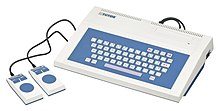TMS9900
[a] Introduced in June 1976, it implemented Texas Instruments's TI-990 minicomputer architecture in a single-chip format, and was initially used for low-end models of that lineup.The minicomputer roots of the TMS9900 give rise to a number of architectural features that are not commonly found on designs that started from a blank sheet.In a minicomputer implementation with fast memory, the effect is relatively small and the upside in a real-time or multi-tasking environment is significant as context switches are common.In the late 1970s Walden C. Rhines gave a presentation of the TMS99110, then code-named "Alpha",[3] to an IBM group developing a personal computer.After dropping out of the personal computer market after products such as TI-99/4A, the company microprocessor division eventually switched focus to the TMS320 special-purpose processor series.[7] The WP points to a base address in external RAM where 16 general purpose user registers (each 16 bits wide) reside to serve the processor.Using BLWP/RTWP, it is possible to nest subroutine calls despite the absence of a stack, however, the programmer needs to assign the appropriate register workspace explicitly.[9] XOP is less flexible than a BLWP, as the transfer vectors have to be at fixed locations, but allows one source operand to be directly addressed rather than passed in a register or otherwise.Another use of XOP was to implement instructions in software which might be handled by dedicated hardware in future versions of the 990 minicomputer series.Unfortunately, to reduce the production costs, TI chose to use just 256 bytes (128 16-bit words) of the fast kind of RAM that the TMS9900 could access directly.The rest of the memory was 16 KB of 8-bit DRAM that was accessible only indirectly through the video display controller, which crippled the performance of these machines.TI developed the TM990 series of computer modules, including CPU, memory, and I/O, which, when plugged into a card frame, could form a 16-bit minicomputer.[14] In the late 1970s, John Walker and Dan Drake developed S100-bus cards based on the TMS9900 and a full software stack to go with it.[17] The next generation of the TMS9900 was the TMS9995, which provided "functional performance at speeds three times faster than any previous 9900 family processor,"[18] largely due to the inclusion of instruction prefetch technology.In the home computer arena, the TMS9995 only found use in the Tomy Tutor, as well as an obscure third-party computer-on-a-card upgrade for the TI-99/4A called the Geneve 9640, and a project printed in Electronics Today: the Powertran Cortex.



Texas InstrumentsDesignEndiannessRegistersGeneral-purpose16-bitmicroprocessorsTI-990minicomputerTI-99/4 and TI-99/4AIntel 8086Motorola 68000Texas Instruments TMS320Token RingTI 990Intersil 6100Fairchild 9440Data GeneralNational SemiconductorIMP-16LSI-11processor registersmain memorycontext switchingWalden C. RhinesIntel 8088IBM PCTI-99/4ATMS320Program counterStatus registerpointssubroutinebig endianorthogonaloperandsexecute instructionexecutesbreakpointaddress busdata busdirect memory accessshift registermemory-mappedTomy Tutor John Walker S100-bus cardsAutodeskGeneve 9640General Instrument CP1600Rhines, Walden C.GitHub